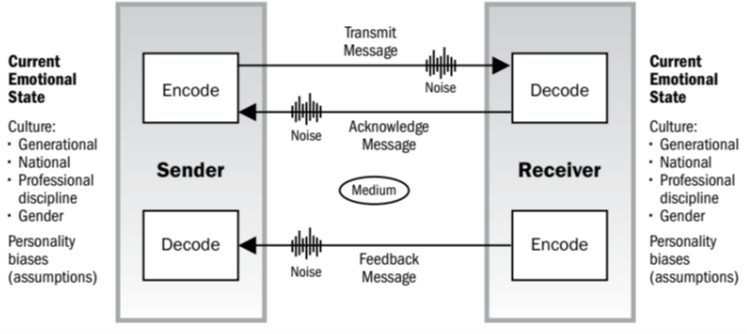Engage and support virtual teams
Enablers
- Examine virtual team member needs. (ECO 1.11.1)
- Investigate alternatives for virtual team member engagement. (ECO 1.11.2)
- Implement options for virtual team member engagement. (ECO 1.11.3)
- Continually evaluate effectiveness of virtual team member engagement. (ECO 1.11.4)
Deliverables, and Tools

Collaboration Technology
Enables teams to plan, collaborate, and communicate
Not a substitute for team planning activities, such as establishing a team charter that details how a team will work together.
Transparency considerations will factor into which collaboration technology is chosen.
Collaboration tools might include:
- Shared task boards and burndown/burnup charts to promote visibility.
- Shared messaging and chat boards to enable quick ad hoc communications.
- Knowledge repositories to store shared documents.
- Video-conferencing tools to create more opportunity for face-to-face collaboration.
Virtual Team Member Needs
Basic needs of a virtual team:
- A shared goal
- A clear purpose
- Clarity on roles and expectations
Project manager must facilitate and ensure collaboration
Alternatives for Virtual Team Member Engagement
Managing engagement requires persistence and a focus on:
- Team dynamics
- Transparency
- Accountability
- Attention to effective communication
Use videoconferencing tools to facilitate active participation and the ability to assess body language and tone.
Enable visibility of the work and work status being done by the virtual team members by using tools such as Kanban-style boards.
Communication
- Effective communication is the key to successful teams.
- The team charter should include communication expectations and details.
- A good retrospective often provides ways that a team can improve its communication, collaboration, and use of visibility tools.

Engagement Assessments
- Identify team members who can successfully form a coherent working team.
- While subject matter expertise is needed, other capabilities such as effective teamwork, collaboration, and communication are important.
- As new members join, the team will cycle through the team development stages of re-forming, storming to produce norms, and continually improving.

Communication Plan
The project manager should facilitate the creation of an initial team communication plan.
Components include:
- When the team meets
- How do team members update status on team task boards and/or burndown charts?
- How often do team members update their work status?
- What are the team’s shared hours?
- What are their preferred communications approaches?
Encourage the team to adopt its own practices and drive iterative improvements to their communication approaches.
Effective collaboration and broad, accurate visibility across stakeholders is the objective.
Conflict Management
- Conflicts and disagreements on any team are inevitable.
- Effective team charters can help the project manager anticipate problematic situations.
- By anticipating situations of possible disagreement, you can decide on a potential solution and how to handle the situation before it even arises.
Guidelines to Implement Options for Virtual Team Member Engagement
- Focus on collaboration and team norms before focusing too much on tools.
- Recognize that team formation in a virtual environment is difficult, so it's critical to reinforce the teams' mutual commitments, achievements, and opportunities.
- Virtual teams will require a significant amount of feedback and reinforcement of the team goals and objectives.
- When possible, provide opportunities for the virtual team members to meet in person, build relationships, have fun together, and nurture their shared commitment to the project’s goals.
Calendar Tools
Shared calendars are available in many tools to help team members plan meetings, coordinate feedback, and improve visibility into project goals and activity status.
- In general, timeboxing meetings improve:
- Focus
- Encourage the team to set clear agendas and objectives
- Help with keeping the work on track.
The team must decide how best to manage its calendar with an eye toward the goal of visibility among the team and relevant stakeholders.
Variance Analysis
Variance * is defined as a quantifiable deviation, departure, or divergence away from a known baseline or expected value.
As the team works, the project manager may produce variance analysis, such as:
- Accuracy of team estimates
- Delivery in a sprint or by an established milestone
- Team performance against targets—perhaps measured by story points completed or successful burndown during an iteration.
Results of a variance analysis may be shared with the team as part of a retrospective to serve as:
- The basis for problem solving
- Identification of lessons learned
- Proposed experiments to improve team performance in subsequent iterations
Powers of a PM
- For virtual teams, the risk of individual team members becoming isolated from other team members is inherent.
- Important to focus on shared commitments vs. individual accomplishments regarding task.
- By instilling a sense of shared commitments into the team starting with the team charter, then team members will adopt certain behaviors to reinforce collaboration and promote visibility.
- As a project manager of a virtual team, you must reinforce the team goals over individual performance, and enable teams to self-organize and be accountable for deliverables.
Guidelines to Continually Evaluate the Effectiveness of Virtual Team Member Engagement
- Track the progress of your teams as they carry out the work and produce deliverables.
- Ensure meetings like daily standups are not just status updates, but value commitments from the team to itself.
- Use videoconferencing tools.
- Timebox your meetings. All the best practices of effective meetings apply.